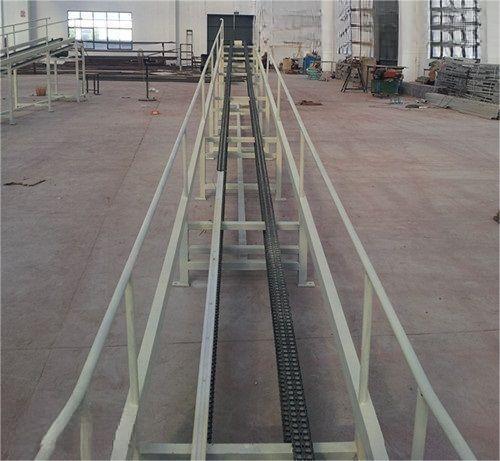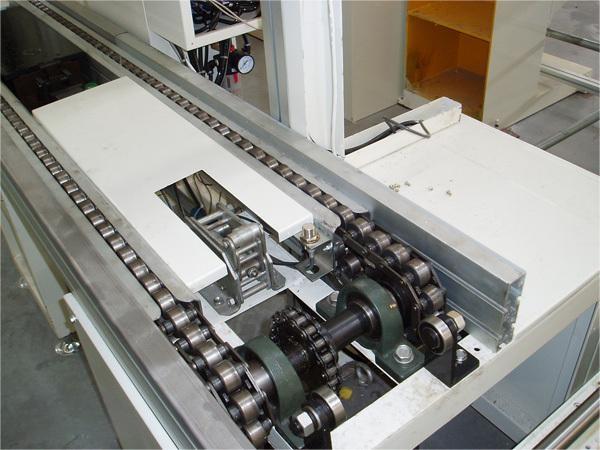Introduction to Chain Conveyor Lines
Chain as a traction and load-bearing device for conveying materials. Chain conveyor lines can also be referred to as chain lines. The chain conveyor line is a device that uses chains as traction and load-bearing bodies to transport materials. The chains can be ordinary sleeve roller conveyor chains, or various other special chains (such as stacking chains and double speed chains) can be used. The chain conveyor line mainly transports pallets, large turnover boxes, etc.
Chain conveyor line is a widely used assembly line conveying equipment. Chain conveyor line is non-standard equipment, and customers can customize it according to their needs.
Chain conveyor line working principle
The chain conveyor line is on the load-bearing chain, with a higher load-bearing roller attachment added between each section to carry the goods. And the chain uses rollers to roll and slide with the track. Due to the rolling contact between the rollers on the chain and the track, the frictional resistance is small, the power loss is low, and it can bear heavy loads. Its load-bearing capacity is related to the strength of the bracket, chain size, roller size, and material. The roller material is generally steel, but in some cases, wear-resistant engineering plastics are used to reduce noise.
The conveyor chain has a variety of structural forms and accessories, making it easy to achieve stacking and conveying. It can be used as an assembly production line or as a storage and conveying material.
Chain conveyor line characteristics

1. The chain production line is mainly composed of three parts: conveyor frame, chain, and power device. The conveyor frame serves as the main part, the chain serves as the conveyor carrier, and the power device provides power for equipment operation. The main body of the conveyor frame is made of steel as the main material for production, as it bears a large amount of cargo weight.
2. The engineer designs a plan that matches the requirements proposed by the customer, taking into account actual production conditions, products, and other factors. After the plan is determined, it is handed over to the production department to arrange the procurement of materials required for production, as well as to arrange personnel for production. The relevant materials are processed according to the requirements of the drawings.
3. Assembly of conveyor frame: Throughout production, the first step is to complete the production of the conveyor frame, which is the main component of the chain conveyor line. The staff will cut the steel and assemble it into shape through welding according to the design drawings. When connecting the conveyor frame, attention should be paid to keeping all parts at the same level.
4. Equipment coating: After the conveyor frame of the chain production line is assembled by welding, the entire equipment needs to be coated. The color can be freely selected for coating, and after the coating is completed, the equipment will be "dried" in a ventilated area.
5. Installation of power device: Chain production lines are generally used to transport heavy items. The power required for chain transmission is provided by motors, and the selection of motors can be specified by the customer. The power unit is installed on the high side of the conveyor frame.
6. Installation of conveyor chain: After installing the power device, the chain used for transporting goods needs to be installed on the conveyor frame. When installing the conveyor chain, it is important to pay attention to whether the connection between the chains is tight to avoid disconnection during equipment operation. At this point, a high-efficiency chain conveyor line has been completed, and the equipment needs to undergo pre factory operation testing by engineers to ensure its normal operation. [1]
Chain conveyor line structure

1. Prime mover: The prime mover is the source of power for the conveyor line, usually using an AC motor, but sometimes a variable frequency motor is used as needed. 2. Drive device: The motor is connected to the conveyor head shaft through the drive device, and the usual functions to be achieved include: reducing speed, mechanical speed regulation, and safety protection.
3. Line body: The line body is the main body of the conveying equipment that directly completes the material conveying project. It mainly consists of conveying chains, accessories, sprockets, head shafts, tail shafts, tracks, brackets, and other parts.
4. Tensioning device: The main function of the tensioning device is to pull the tail shaft closer;
5. Electric control device: The main function of the electric control device is to control the driving device.
Chain conveyor
Chain conveyor is a kind of conveyor that uses chain traction and load, or uses Flat noodles, metal mesh belt and roller bed installed on the chain to carry materials. It can be divided into chain type, chain plate type, chain net type and Flat noodles type. It often forms various functional production lines with other conveyors, lifting devices, etc.
Chain conveyor line improvement
problem analysis
As an important equipment for collecting and transporting finished materials, chain conveyors are composed of 9 7.5-meter chain tracks, 3 transmission shafts equipped with sprockets, and 1 drive motor reducer. The chain bypasses the sprocket on the transmission shaft and forms a closed ring with the head and tail sprockets on the chain path. With the traction of the chain, it carries the load to continuously transport steel. The drive of the chain is completed by the transmission device, and the motor is started to transmit power to the main shaft equipped with the sprocket through a reducer. Under the drive of the chain wheel, the chain moves to achieve the purpose of transporting steel. Due to the increased production rhythm, the conveyor is often overloaded or blocked, resulting in increased running resistance and overloaded motor operation. In order to meet the requirement of no oil stains on the finished material, the transmission bearings cannot be lubricated in a timely manner after long-term use, which also leads to an increase in motor power and the occurrence of motor burnout and tooth cracking. At present, the main drive sprocket of chain conveyors is an integrated type, which is hot installed on the transmission shaft and fixed by a positioning pin. During movement with significant impact, relative movement between the sprocket and the transmission shaft often occurs, causing wear and tear of the sprocket and the transmission shaft. Inconsistent movement of 9 sets of chains, affecting transportation. Due to the significant increase in production pace, the failure rate of the mechanism also increased sharply. Finally, the sprocket and transmission shaft had to be firmly welded together, making the equipment that could have been disassembled and replaced into a disposable one. Secondly, due to continuous wear and tear during long-term use, the sprocket is prone to wear and tear, resulting in unstable engagement between the sprocket and the chain. If the sprocket needs to be replaced, the entire transmission shaft needs to be removed before replacement, which can have a long impact time and high labor intensity for workers.
Chain conveyor line technical improvements
1. Improve driving methods and increase load capacity
Redesign the transmission method, install another transmission shaft on the other side of the transmission shaft, and install the motor base according to on-site conditions, and select a new drive motor. Change the original one-way drive to bidirectional drive and add a frequency converter to ensure the service life of the motor while improving the load capacity of the conveyor.
2. Selection of transmission bearings
Ensure smooth operation of the conveyor. Whether the bearings inside the sprocket can move freely is an important condition for the normal operation of the conveyor. However, in practical situations, the gap between the bearing and the pin shaft is often filled with impurities such as oxide scale until it rusts to death, making it unable to rotate freely and the chain in a dry friction state, leading to wear of the pin shaft and sprocket, causing chain fracture and jamming, and affecting production. In order to maintain good lubrication conditions and normal working environment for the bearings, self sealed bearings are re selected to prevent lubricant leakage and invasion of dust, water vapor, or other pollutants, fully utilizing the working performance of the bearings and extending their service life. The bearing sealing device refers to the installation of sealing elements on the rotating shaft or box hole, such as felt rings, rubber sealing rings, cover plates, and labyrinth type shaft stops. Its function is to protect the bearing and prevent external dust, dirt, metal particles, moisture, acid gas, and other debris from entering the interior of the bearing. If the seal of the bearing is poor and external debris invades, the working condition of the bearing will significantly deteriorate, and the service life of the bearing will be significantly reduced. [2]
Another function of the bearing sealing device is to prevent grease leakage from the bearing components. If oil leaks, it will quickly damage the normal lubrication of the bearing, causing it to burn out due to heating; In addition, poor sealing devices not only cause waste due to oil leakage, but also pollute mechanical equipment and processed products. Therefore, in order for the equipment to operate normally, the bearings must have good sealing devices.
When selecting the type of bearing sealing device, the following factors should be considered: (1) the working environment of the bearing; (2) Structural characteristics of bearing components; (3) The rotational speed of the bearing (the circumferential speed of the bearing); (4) The type of lubricant used for bearings (lubricating oil or grease); (5) The working temperature of the bearing; (6) Manufacturing costs.
External sealing can be divided into two types: non-contact and contact. The description is as follows: (1) Contact sealing, as the name suggests, refers to a sealing cover that is in contact with the bearing parts with relative motion and has no clearance. This sealing form, due to direct contact between the sealing element and the mating element, generates friction and heat during rotation, which is prone to lubrication problems. The contact surface is prone to wear and tear, resulting in a decrease in the sealing effect of the bearing and a failure to meet the required quality. Therefore, contact sealed bearings are only suitable for medium and low speed working environments. (2) Non contact sealing refers to the sealing where the bearing parts that move relative to the sealing element do not come into contact and there is an appropriate gap in the middle. This sealing form generates almost no frictional heat during bearing rotation, and the sealing cover is not worn. This form is suitable for high-speed and high-temperature working environments. The smaller the gap between non-contact seals, the better. According to the working condition of the bearing and the requirements of the working environment for the sealing degree, 2RS type sealed bearings are selected. Ensure that the bearing does not harden due to the accumulation of impurities, thereby extending the lifespan of the bearing.
3. Improving connection methods
Redesign the transmission shaft and split sprocket, which are connected together through bolts and fixed on the transmission shaft using positioning keys. Change the original integrated connection between the transmission shaft and sprocket to a split connection. After the sprocket teeth are worn, they can be quickly replaced.
GIDI CHAIN LIMITED supply lots of roller chain, conveyor chain, Leaf Chain, welded chain, forged chain, Palm Oil Mill Chain, Hoisting Chain,Mine and Metallurgy Chain, etc. totaling over 3000 varieties. and 90% of chains are exported to worldwide, Which mainly export to Southeast Asia, European, North America, South America. Chains are welcomed by customers with the excellent quality. Our company owns more than 100 sets of advanced and professional manufacturing equipment, Perfect and rigorous QC system is implemented in every process from material purchasing to finished products packaging. Also, we have passed the ISO9001: 2015 Quality Management System Certification.
More Detail : www.gidi-chain.com
